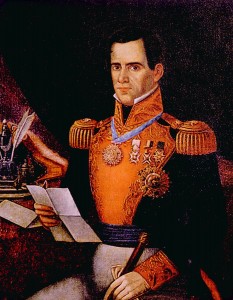
During the US armed forces’ 400+ year history, the nation’s troops have squared off against an array of cunning enemy commanders. Among these, arguably none is as fascinating a character as Antonio López de Santa Anna, Mexico’s leading military figure and statesman of the nineteenth century.
A (formerly) living testament to his homeland’s chronic political instability, Santa Anna held power as El Presidente on eleven different occasions during a span of just over two decades. Charismatic and somewhat capable as a military leader, he was also opportunistic and corrupt. He rose through the ranks of the colonial Spanish Army fighting rebel forces in the Mexican War for Independence (1810-1821) only to switch sides once it was clear the insurgents would win. He then used what influence and fame he had acquired to line his own pockets. He loved luxury and had a lifelong gambling addiction he needed to support.
As a military commander, Santa Anna proved remarkably adept at rallying his countrymen to his banner, only to let them down again and again with elaborate, but slipshod and poorly executed plans. His worst performance came during the Texas Revolution (1835-1836). At the Battle of the Alamo (23 February – 6 March 1836) one-third of the forces he ordered into the final assault were killed or wounded — an appalling casualty rate by any standard. His decision to give the Texian defenders no quarter and, three weeks later, to execute 342 prisoners in the Goliad Massacre stiffened the resolve of his opponents; it also rallied American public opinion to the cause of Texan independence. The arrogant overconfidence of the self-styled “Napoleon of the West” (demonstrated by the refusal to post sentries outside his camp) lead to the route of his army at the decisive Battle of San Jacinto.
Thoroughly disgraced by the loss of Texas, Santa Anna headed off into retirement only to return for Mexico’s brief “Pastry War” against the French in 1838-39. He suffered a serious injury during the campaign when his left ankle was shattered by cannon fire. This lead to the amputation of the lower portion of his leg. Brave and battle-scarred, Santa Anna was also arrogant, vain, and a relentless self-promoter. He parlayed his personal loss into political gain. Four years after the war against France had ended, he orchestrated a state funeral for his missing limb. The leg was dug up, put into a crystal container, and given a full military dress parade before being buried in Mexico City. Thereafter, at opportune moments, he rode around holding his prosthetic replacement above his head to remind the country of his personal sacrifice.
The penultimate chapter of Santa Anna’s amazing career was written during the US-Mexican War (1846-1848) when the “Napoleon with the Stump” was bested by the armies of America’s “Napoleon of the Stump.” During the Battle of Cerra Gordo (1847), the Mexican leader suffered what may have been his ultimate indignity. As he was sitting down to enjoy a lunch of roasted chicken, his base camp was overrun by the 4th Regiment Illinois Volunteers. The Mexican commander just managed to flee his tent and hop on a horse before American troops entered his quarters; he didn’t have time to grab his prosthetic leg. Private A. Waldron, First Sergeant Sam Rhodes, and Second Sergeant John M. Gill arrived to find it, a stash of gold coins, and the roasted chicken. The soldiers, ate the chicken, turned over the gold to US commanders, and kept the leg. Years later, Santa Anna’s prosthesis would be donated to the Illinois State Museum in Springfield, IL. Despite repeated protests by the Mexican government, the fake limb remains there to this day.
But wait! There’s more!
Just when it would seem that the unbelievable story of Antonio López de Santa Anna should have come to an end, Mexico’s (anti-)hero returned for his final term in office in April 1853. Adopting the title, “Most Serene Highness” and proclaiming himself “Dictator for Life,” Santa Anna set about once again lining his pockets with state funds. Fed-up with his antics and angered by his decision to sell southern Arizona to the USA (aka, the Gadsden Purchase) even his strongest supporters finally had enough. Mexico’s “Dictator of Life” was overthrown after only fifteen months.
Santa Anna went into Caribbean exile before eventually making his way to New York’s Staten Island. From his temporary US home, he plotted yet another return to Mexico but he needed to raise money to build yet another army. His final scheme involved developing and selling a replacement for rubber using “chicle,” the elastic sap of the tropical sapodilla tree (chewed, for centuries, by Central American inhabitants). Santa Anna enlisted an American acquaintance, Thomas Adams, to assist him. Adams, however failed to produce a suitable rubber substitute. Determined to salvage something from the operation, Adams wrapped up small pieces of chicle in colorful tissue paper and convinced a local drugstore owner to sell them for a penny a piece. The first shipment flew off the shelves in less than a day. The US chewing gum industry was born (2011 sales: $3.5 billion) and with it, one of America’s iconic brand names: Chiclets.
Oh, and Santa Anna.
He was finally allowed to return to his homeland in 1874 a part of a general amnesty. Crippled and nearly blind from cataracts, he lived on for two years in isolation. Ignored by the Mexican government and people, he died in 1876.

 Saving...
Saving...